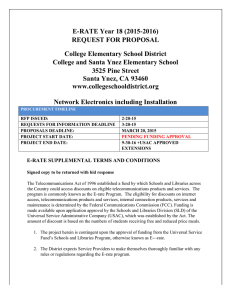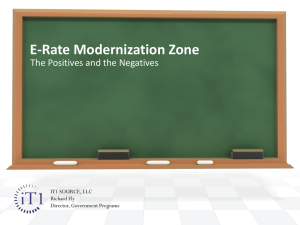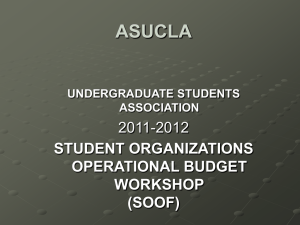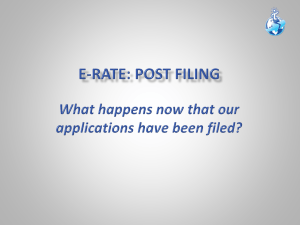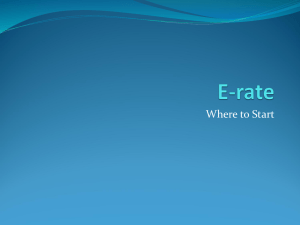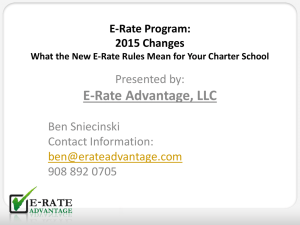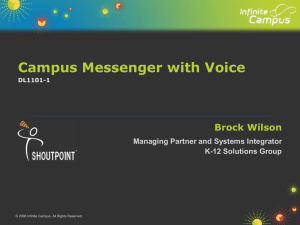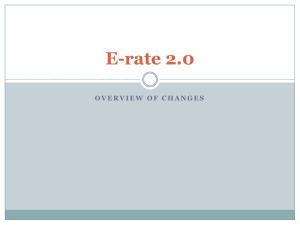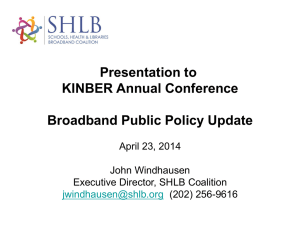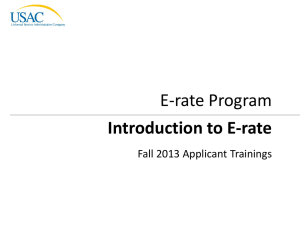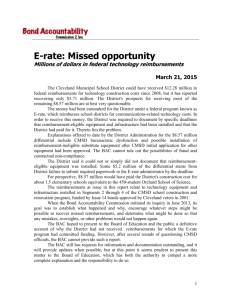What is E-Rate?
advertisement
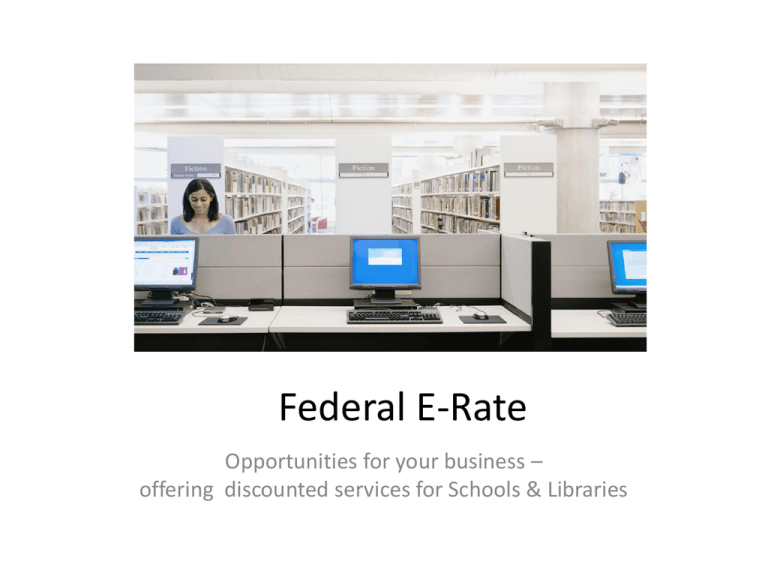
Federal E-Rate Opportunities for your business – offering discounted services for Schools & Libraries What is E-Rate? • The FCC's E-rate program is a program for connecting the nation's schools and libraries to broadband. It is the government's largest educational technology program. When E-rate was established in 1996, only 14 percent of the nation's K-12 classrooms had access to the Internet. Today, virtually all schools and libraries have Internet access. • Universal Service support provides discounts only for telephone service, Internet access and internal connections. The discounts range from 20 to 90 percent, depending on the household income level of students in the community and whether the school or library is located in a rural or urban area. Who Pays for Universal Service Programs? • All telecommunications service providers and certain other providers of telecommunications must contribute to the federal USF based on a percentage of their interstate and international end-user telecommunications revenues. These companies include wireline, wireless phone companies, paging service companies and Interconnected Voice over Internet Protocol (VoIP) providers. These telecom companies may pass on these contributions to their end users through federal USF surcharges. • Contributions telecom providers make to USF fund these programs: – Lifeline/Link Up. This program provides discounts on monthly service and initial telephone installation or activation fees for primary residences to income-eligible consumers. – High-Cost. This program ensures that consumers in all regions of the nation have access to telecommunications services at rates that are affordable and reasonably comparable to those in urban areas. – Schools and Libraries. This program makes discounts available to eligible schools and libraries for eligible telecommunications services, Internet access and internal connections so that schools and libraries may have access to affordable telecommunications and information services. – Rural Health Care. This program helps link health care providers located in rural areas to urban medical centers so that patients living in rural America will have access to the same advanced diagnostic and other medical services that are enjoyed in urban communities. Advantages to Obtaining a SPIN to Participate in the E-Rate Program • Offer Schools & Libraries discounts on services they need to purchase • Your company will be prepared and ready to act should an opportunity come through. • Opportunity to compete for business • Identify leads through USAC’s Search Tools: http://www.usac.org/sp/tools/default.aspx • No outlay of money by your company for being able to offer discounted services Getting Started • Must have a FRN & Filer ID number prior to submitting a 498 form • Fill out Form 498 to obtain Service Provider Identification Number (SPIN): http://www.usac.org/sp/tools/forms.aspx – Block 3 requires the service provider’s Federal Employer Identification Number (Federal EIN or tax ID number), business structure, and Dunn and Bradstreet Identification Number (DUNS). http://www.dnb.com/get-a-dunsnumber.html – Page 7- Automated Clearing House (ACH) information: Financial institution information is required. Electronic payment of universal service support payments is mandated by the Debt Collection Improvement Act of 1996. – Block 17: Principal Communications Business Types – This must match the Business Types you have selected on your 499-A filing in Block 1, Line Item 105. • • High Cost, Low Income, Rural Health Care programs SPIN assignment in 2-4 weeks Schools & Libraries Applicants • Refer potential S&L applicants to: http://www.usac.org/sl/about/gettingstarted/default.aspx – Eligibility – Services eligible for discount – Application process • The process starts with a request for services and ends when the Applicant selects a cost-effective provider. Then a contract is signed, and the discounted services can begin. Invoicing for Services • USAC can process invoices from either the applicant or the service provider after the following have occurred: – USAC has issued a Funding Commitment Decision Letter (FCDL) with a positive funding commitment; – Services have started (USAC can process invoices for progress payments after review of the contract if it includes a specific payment schedule); – The applicant has submitted, and USAC has successfully processed, an FCC Form 486; and – The service provider has filed an FCC Form 473 for the relevant funding year. • There are two methods that can be used to invoice USAC. Once USAC has processed an invoice for a Funding Request Number (FRN), that method of invoicing must be used for that FRN for the remainder of the invoicing process. Invoicing Method #1 • – • Invoicing Method #2 – – – • Applicants file the FCC Form 472, Billed Entity Applicant Reimbursement (BEAR) Form if they have paid you in full for the services and want to be reimbursed for the discount amount. You file the FCC Form 474, Service Provider Invoice (SPI) Form if you have billed the applicant for the non-discount amount (the applicant's share of the cost) and want to be reimbursed for the discount amount. USAC will review the SPI Form and process a payment to you if payment is approved. The applicant is always required to pay the non-discount portion of the cost of the services. USAC strongly encourages electronic invoicing for service providers that will frequently bill USAC or for those that submit only a few line items for each invoice. Those service providers should use the online filing option for the FCC Form 474. • http://www.usac.org/sl/service-providers/step05/electronic-invoicing.aspx Links to Information • Service Provider Information: http://www.usac.org/sp/ • Forms: Applicants and Providers – http://www.usac.org/sl/tools/forms/default.aspx • Program Deadlines: http://www.usac.org/sl/tools/deadlines/default.aspx • Search Tools: http://www.usac.org/sl/tools/default.aspx • Eligible Services List http://www.usac.org/sl/applicants/beforeyoubegin/eligible-services-list.aspx • Samples and Examples: http://www.usac.org/sl/tools/samples.aspx • Latest News: http://www.usac.org/sl/tools/news/default.aspx • Acronyms and Terms: http://www.usac.org/_res/documents/sl/pdf/handouts/SL-Glossaryof-Terms.pdf Schools & Libraries News Brief Subscription • http://www.usac.org/about/tools/publications/subscription-center.aspx • Commitments for Funding Years 2013 and 2012 • Funding Year 2013. USAC will release Funding Year (FY) 2013 Wave 13 Funding Commitment Decision Letters (FCDLs) August 14. This wave includes commitments for approved Priority 1 (Telecommunications Services and Internet Access) requests at all discount levels. As of August 9, FY2013 commitments total over $338 million and encompass 18,555 of FY2013 applications. • Funding Year 2012. USAC will release FY2012 Wave 55 FCDLs August 15. This wave includes commitments for approved Priority 2 (Internal Connections and Basic Maintenance) requests at 90 percent and denials at 89 percent and below. As of August 9, FY2012 commitments total over $2.71 billion. • On the day the FCDLs are mailed, you can check to see if you have a commitment by using USAC's Automated Search of Commitments tool. Does the FCC’s Schools and Libraries Support Mechanism Duplicate State and Local Efforts? • No. The FCC's Schools and Libraries program complements the efforts of states and localities to link the nation’s classrooms and libraries to the information superhighway. • Most states do not allow VoIP providers to participate in state programs, but may require contributions based on Intrastate revenue. What’s New? – FCC asking for Comments • July 19, 2013 - FCC LAUNCHES MODERNIZATION OF E-RATE PROGRAM TO DELIVER STUDENTS & TEACHERS ACCESS TO HIGHCAPACITY BROADBAND NATIONWIDE • Modernization of the E-rate program will be built around 3 goals: increased broadband capacity, cost-effective purchasing, and streamlined program administration. • To meet the needs of today's students, teachers, and library patrons the Commission sets forth three proposed goals to modernize the E-rate program and seeks comment on options to advance these goals: – Increased connectivity to high-capacity broadband – Efficient purchasing through bulk buying, consortia, and competitive bidding improvements – Cutting red tape to speed up, streamline, and increase transparency in application reviews Comments (Cont’d) • The proposal also seeks comment on a variety of other issues, including the applicability of the Children's Internet Protection Act (CIPA) to devices brought into schools and libraries and to devices provided by schools and libraries for at-home use; adjusting to changes in the National School Lunch Program that affect E-rate; additional measures for protecting the program from waste, fraud and abuse; wireless community hotspots; and the adoption of E-rate program procedures in the event of a national emergency or natural disaster. Q&A Contact Information • Carol Lisowski, Regulatory Consultant, CHLSolutions • CHLSolutions@msn.com (702) 497.8730 • Karen Lindquist, E-Rate Specialist • Lindquist.CHLSolutions@live.com • www.telecom-regulatory-compliance.com
